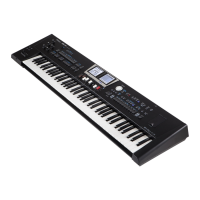Playing the BK-9’s Real-Time Parts
32
Organ eects
If you selected Harmonic Bars the left display shows the organ
parameter available.
Left Display
1. Press the selection button placed under the left display to
enable it.
2. Use the dial to edit the parameter you want to change.
Parameter Value Explanation
Percussion
2nd
Percussion of the same pitch as the 4’ harmonic bar
will be heard.
3rd
Percussion of the same pitch as the 2-2/3’ harmonic
bar will be heard.
SOFT
• SOFT
The percussion sound will be decreased, and the
harmonic bars will have their usual volume.
The volume when percussion is softened can
be adjusted by the parameter”PercSoftLevel” (p.
134).
• NORMAL (“SOFT” not active)
The percussion sound will be normal.
The volume of percussion can be adjusted by
the parameter “PercNormalLevel” (p. 134).
SLOW
• SLOW
The percussion sound will decay more slowly,
producing a gentler attack.
The percussion decay time can be adjusted by
the parameter “PercSlowTime” (p. 134).
• FAST (“SLOW” not active)
The percussion sound will decay fast.
The percussion decay time can be adjusted by
the parameter “PercFastTime” (p. 134).
VIB/CHORUS
OFF, ON
You can apply vibrato or chorus to the organ
sound.
V-1, V-2, V-3
C-1, C-2, C-3
The eect will intensify as the vibrato type (V-1,
V-2, V-3) or chorus type (C-1, C-2, C-3) moves to a
higher number
AMPLIFIER
TYPE
I, II, III, IV, V
The BK-9 simulates four dierent amp types, allow-
ing you to produce various kinds of distortion. For
more details see “Amp Type” (p. 136).
AMPLIFIER
OVERDRIVE
0~127
A value toward 127 raise the gain, adding
distortion to the sound.
TONE WHEEL
Leakage
0~127 You can adjust the level of the leakage noise.
ROTARY
BRAKE
Switches the rotation of the rotary speaker. When
this is turned on, the rotation will gradually stop.
When it is turned o, the rotation will gradually
resume.
SLOW, FAST Change the speeds of the Rotary eect.
OFF, ON Enable or disable the rotary.
To make additional detailed settings for the tonewheel organ see
“Organ Commons” (p. 134).
Play Dierent Voices with the Left
and Right Hands (Split)
1. Press the [SPLIT] button
The [SPLIT] button lights.
The BK-9 is now in Split mode: note numbers below the split point
are used to transpose rhythm playback in real-time and to play
the Lower and Manual Bass part (if they are active). Note numbers
above the split point can be used to play melodies using the Upper
parts.
C4 (default)
Lower and M. Bass
Upper parts
Split Point
2. Press the PART ON/OFF [UPPER 1] and the [LOWER] button
to activate the Upper and Lower part.
3. Play the keyboard.
The notes you play with your left hand sound the Lower part , while
the notes you play with your right sound the Upper 1 part.
4. Press the PART ON/OFF [UPPER 2] button.
The notes you play with your right hand sound the Upper 1 and
Upper 2 part in layer.
5. Press the PART ON/OFF [M. BASS] button.
• If the Lower part is active a monophonic bass part is added to
the left hand. The bass notes depend on the chords you play.
• If the Lower part is not active a polyphonic bass part is added to
the left hand. The bass notes depend on the real notes you play.
MEMO
The default setting for the split point is note number 60 (C4).
You can change the split point to a dierent note (“Split Point”
(p. 136).

